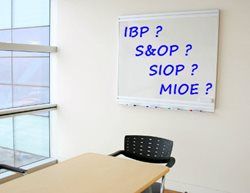
 Hundreds of companies struggling to improve their supply chain performance have adopted an effective business decision-making process to balance and align demand and supply. According to Aberdeen Group, this process can result in a 14% increase in operating margin, a 4% increase in gross margin dollars, a 55% reduction in inventory write-offs, a 17% increase in new product revenues, and a 35% reduction in lost sales. Great!
Hundreds of companies struggling to improve their supply chain performance have adopted an effective business decision-making process to balance and align demand and supply. According to Aberdeen Group, this process can result in a 14% increase in operating margin, a 4% increase in gross margin dollars, a 55% reduction in inventory write-offs, a 17% increase in new product revenues, and a 35% reduction in lost sales. Great!
So what do we call this thing that has such huge potential to lower costs, increase agility, and improve customer service, while also raising profits? Research firms, solution providers, and pundits can’t seem to decide. Some refer to it as Sales & Operations Planning (S&OP or SOP). Some call it Sales, Inventory and Operations Planning (SIOP). Others go with Integrated Business Planning (IBP). And then there’s Merchandizing, Inventory and Operations Execution (MIOE), for the retail sector. It’s all rather confusing, even in the confusing world of supply chain terminology.
Over time, analysts may lead us to a standardized term, but it’s useful right now to break this balancing act into three overlapping planning horizons: Executional, Tactical, and Strategic.
Executional deals with balancing and aligning demand and supply over the near-term, often within the span of the planning cycle. Decisions tend to be prompted by exceptions and disruptions to demand and/or supply, and are made on the fly to ensure customer orders are met and financial objectives are made. This near-term planning horizon involves workflow, exception-based messaging, alerts, and visibility to supply, demand, and transportation. Often, specific scenarios are analyzed (e.g. can a customer order be accepted, should we work overtime, is expedited shipping the best option)?
Tactical deals with the mid-term, which may mean anything from a few months to 18 months or more, depending on the business. The purpose is to plan far enough ahead at an aggregated level to make effective mid-course adjustments in resources (people and equipment) and partners (suppliers and distribution) to respond to expected changes in demand. New product introductions are planned, product lifecycle decisions are made, product family level demand projections are created, high-level capacity analyses are run, inventory positions are optimized, and adjustments are made to meet expected demand while meeting company objectives (maximizing revenue, gaining market share, etc.). A multitude of scenarios can be run, including optimistic versus pessimistic plans, product launch curve options, inventory postponement alternatives, the impact of adding additional suppliers or production equipment, outsourcing decisions, transportation and warehousing alternatives, and material or component changes.
Strategic deals with high-level balancing and alignment over longer term horizons. Companies may look out three, five or even ten years to plan for new category introductions, plant location adjustments, and/or moving into new countries or regions. Some call this Integrated Business Planning (IBP), while others also include Tactical activities under the IBP umbrella. Alternative scenarios are used to make financial projections, plan investments and compare potential strategy outcomes.
Which brings us back to all the terms. Here’s my opinion:
Sales & Operations Planning (S&OP or SOP).
A traditional term whose definition doesn’t seem to stretch far enough to cover all the bases including volumetric balancing of supply and demand.
Sales, Inventory and Operations Planning (SIOP).
An attempt to emphasize the importance of inventory. Part of the basic S&OP process is the planning and optimization of inventory. The importance of managing inventory is stressed in almost all of the definitions and descriptions I have seen for S&OP and IBP.
Merchandizing, Inventory and Operations Execution (MIOE).
Retail industry synonym for S&OP. MIOE pretty much deals with the Tactical level: establishing a periodic planning process that meets the requirements of each business function, integrates company strategy with execution activities, and balances demand and supply while exceeding customer expectations. Retail supply chain terminology varies just enough from manufacturing/distribution lingo to make things confusing. Retail planning activities (Merchandize Planning, Allocation, Store Labor Requirements, and Distribution & Transportation Requirements) parallel the elements of what manufacturers call S&OP. Can’t blame the Retail Industry for having their own terminology for S&OP, but as Shakespeare has pointed out, a rose by any other name would smell as sweet.
Integrated Business Planning (IBP).
Perfect “one term to rule them all,” covering S&OP, SIOP and MIOE across all time-frames. Whether we hail from sales, inventory, marketing, purchasing, production, or finance, we all are from the same business and are engaged in planning activities that are closely interconnected or integrated.
For me, Integrated Business Planning (IBP) covers it all and cuts down on the alphabet soup. Learn more about how to make IBP a success in your company here.



